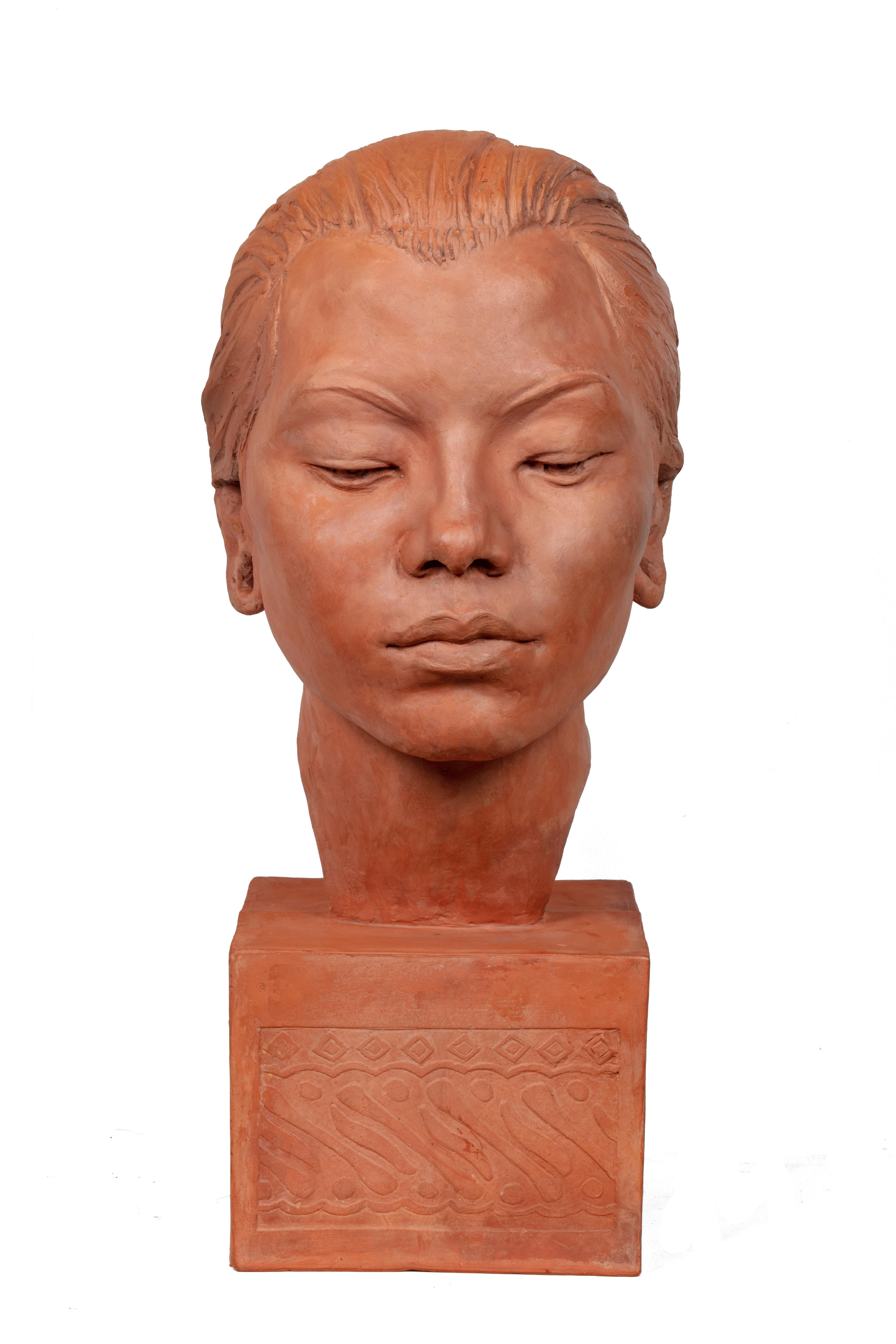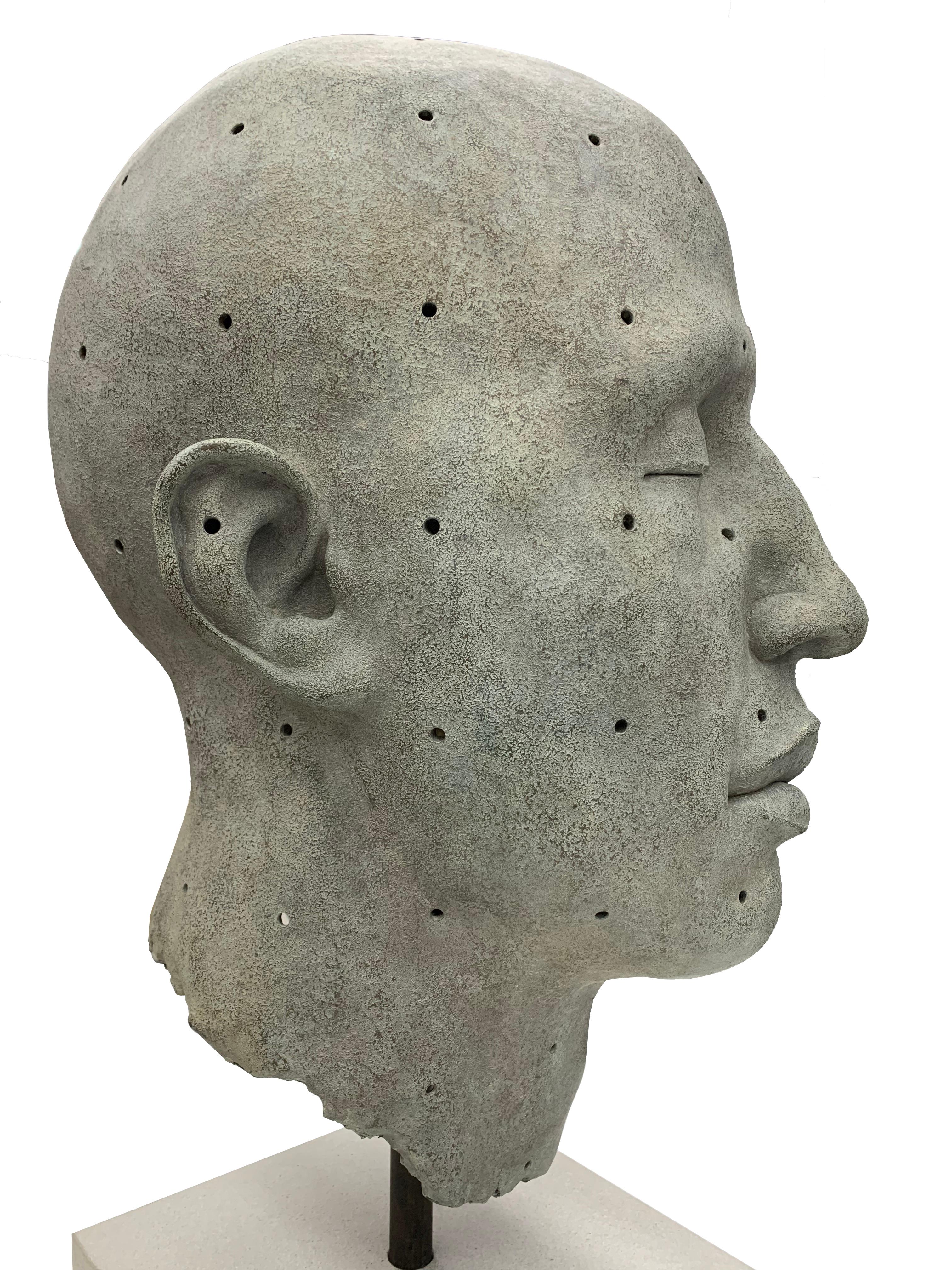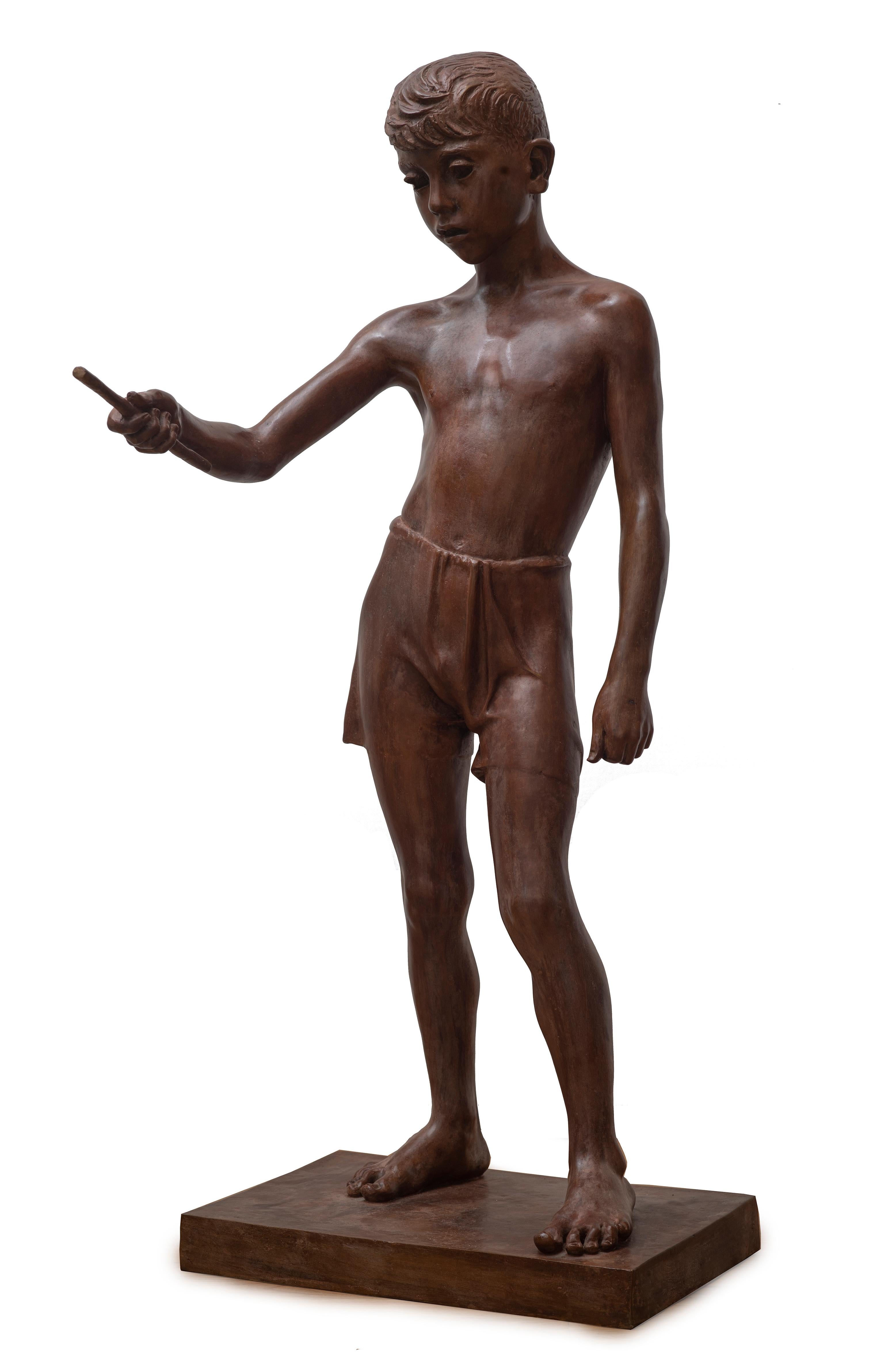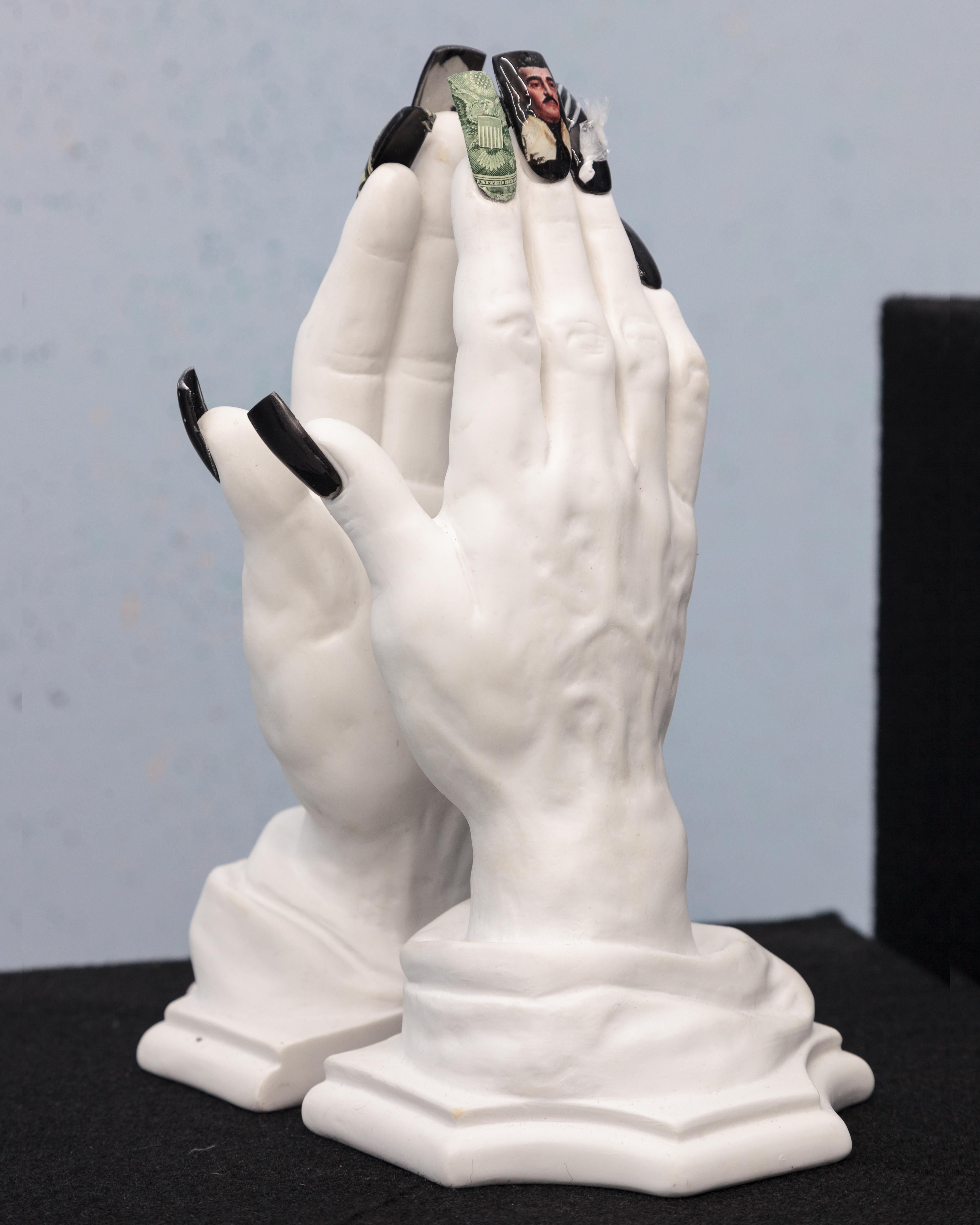Francisco ZúñigaDos Mujeres Mayas (Two Mayan Women)1983
1983
About the Item
- Creator:Francisco Zúñiga (1912 - 1998, Costa Rican)
- Creation Year:1983
- Dimensions:Height: 32.75 in (83.19 cm)Width: 41.25 in (104.78 cm)Depth: 1.25 in (3.18 cm)
- Movement & Style:
- Period:
- Condition:
- Gallery Location:San Francisco, CA
- Reference Number:
Francisco Zúñiga
Known as one of the most important Expressionist artists to emerge from Latin America, Francisco Zúñiga is remembered for his monumental sculptures, figurative paintings and prints, nude drawings and portraits of Central America’s rural indigenous women.
Born in San José, Costa Rica, in 1912, Zúñiga’s exposure to artistic sculpture began at the age of 13, when he worked with his father, Manuel Maria Zúñiga, carving religious figures for local churches. Spurred by a growing interest in art, Zúñiga attended San José’s School of Fine Arts, where he became influenced by classical, renaissance figurative art. After winning several local awards for his prodigious talent, Zúñiga left San José for Mexico City in 1936.
In Mexico City, he attended La Esmeralda, the painting and sculpture school of the National Institute of Fine Arts. There, Zúñiga studied under sculptor Oliverio Martinez and painter Manuel Rodriguez Lozano.
In 1938, Zúñiga joined the faculty at La Esmeralda, where he taught sculpture and painting until 1970. Meanwhile, during the early 1940s, Zúñiga’s works began to attract the attention of art critics in the United States as well as important collectors. In 1941, the Arts Club of Chicago included him as part of their “Thirteen Mexican Artists” group show. The following year, Alfred Barr, director of the Museum of Modern Art in New York, purchased one of his stone sculptures for MoMA’s permanent collection. Then, in 1943, New York’s Metropolitan Museum of Art acquired two of Zúñiga’s drawings.
Throughout most of his career, Zúñiga limited his subject matter to indigenous peasant women. However, he experimented with working with a variety of materials for his sculptures — bronze, alabaster, plaster, marble and modeling clay — and sought new media to create his art. (He made his first lithograph at age 60.)
Zúñiga won countless accolades in his lifetime. He won international awards for 35 of his public sculptures along with other works, and in 1992, he won Mexico’s highest cultural award, the Premio Nacional de Calidad.
Even after his death in 1998, Zúñiga’s legacy lives on. His sculptures, drawings, paintings and prints are found in museums around the world, including MoMA and the Met in New York, the Museum of Modern Art in Mexico City, the Fogg Museum at Harvard University, the Hirshhorn Museum and Sculpture Garden in Washington, D.C., the Middleheim Museum in Antwerp, Belgium and the Open-Air Museum in Hakone, Japan.
On 1stDibs, discover a range of Francisco Zúñiga prints, drawings and paintings.
- ShippingRetrieving quote...Ships From: San Francisco, CA
- Return PolicyA return for this item may be initiated within 7 days of delivery.
- The Foundry WorkerLocated in San Francisco, CAThis sculpture "The Foundry Worker" c.1925 is a bronze sculpture by German artist Albert Caasmann, 1886-1968. The signature is impressed in the bronze. The subject size is 11.15 x 8.15 x 3.15 inches, including marble base, the size is 13.15 x 8.15 x 5 inches. It is in excellent condition. about the artist: Albert Caasmann (2 June 1886 – 23 March 1968) was a German sculptor and porcelain artist. Caasmann designed toy figures for the Berlin toy company Lineol and from 1919 to 1952 was the lead designer and production manager for the company. He designed figurines for the porcelain companies Rosenthal AG and Volkstedt. Caasmann's work for the company Rosenthal are exhibited in the Porzellanikon's Rosenthal Museum. Lineol toy figures modeled by Caasmann are in the Historical Toy Museum in Freinsheim and the Toy museum in Havelland. Albert Caasmann was born on 2 June 1886 in Berlin, Germany. From 1909 to 1919, he worked as a freelancer for the Berlin toy company Lineol, founded by Oskar Wiederholz in 1906. After service as a soldier in the First World War, he became the leading designer and production manager of Lineol from 1919 to 1952. He designed over 600 figures for Lineol, including soldiers, animals, Indians, knights, fairy figures, and railroad figures. His toy figures were widely used in the region by children. Lineol ceased operations in 1965, and in 1985 the company Lineol Duscha has the trademark rights to Lineol. Lineol Duscha reproduces Lineol figures modeled before 1945. Lineol toy figures modeled by Caasmann are in the Historical Toy Museum in Freinsheim and the Toy museum in Havelland. Caasmann spent time in the Berlin Zoo, where he modeled his animal models. He made a model for a porcelain cheetah...Category
Early 20th Century Realist Figurative Sculptures
MaterialsBronze
- Chevre Allongee (Reclining Goat)Located in San Francisco, CAThis artwork "Chevre Allongee (Reclining Goat)" c. 1860, is bronze sculpture after renown French artist Antoine Louis Barye, 1796-1875. Signature is impressed in the bronze. The subject size is 4.25 x 7 x 3.35 inches, including marble base is 5.25 x 4 x 7.75 inches. It is in excellent condition. About the artist: Antoine-Louis Barye lived his entire life in Paris and may never have left France. He was born in 1795 (a date revised in the 1990s from 1796 as a result of Martin Sonnabend's recalculation of the Revolutionary calendar). He is reported to have had minimal formal schooling even in reading, and to have acquired his extensive liberal-arts education on his own. His initial professional training was in metalwork: first with his father, a goldsmith from Lyons, then with a metal engraver in military equipment, and finally with Martin-Guillaume Biennais (active 1800-1832), then master goldsmith to Napoleon. After serving in the army from 1812 to 1814, Barye trained in the fine arts with sculptor François-Joseph Bosio (1768-1845) and painter Baron Gros (1771-1835). He then studied at the Ecole des Beaux-Arts from 1818 to 1823. His miniature medallion, Milo of Crotona Devoured by a Lion, won an honorable mention in metal engraving in 1819, but he failed to win the Prix de Rome. He worked as a craftsman for the goldsmith Jacques-Henri Fauconnier (1779-1839) from 1823 to 1831 and made his Salon debut in 1827 with a selection of busts. Barye made his critical and public mark as a sculptor four years later, in the Salon of 1831, with groups representing predatory violence in the wild. His first government commission came soon after, precisely for such a subject. The Minister of the Interior purchased Barye's monumental plaster Lion (since called Lion Crushing a Serpent), shown in 1833, and had it cast in bronze by Honoré Gonon and shown in 1836, before placing it in the public Tuileries Gardens (now Musée du Louvre, Paris). In 1834 Barye was chosen for a project that was never executed, the colossal eagle as the crowning element of the triumphal arch at the Etoile. Around 1836 the government commissioned him to execute the emblematic animal decoration on the July Column at the place de la Bastille, inaugurated in 1840. He produced a monumental effigy of Saint Clotilde for the Church of the Madeleine, Paris, in the early 1840s. In 1846 the government commissioned a pendant Seated Lion for the Tuileries Lion Crushing a Serpent (1847, bronze, Portal, Pavillon de Flore, Palais du Louvre, Paris). During these same years the royal family began buying and commissioning small-scale works from Barye for their private collections. Around 1834, the duc d'Orléans commissioned a highly publicized surtout de table representing hunts of different regions and historical periods, possibly one of several tabletop projects that he ordered from Barye. The duc's sister Marie d'Orléans allegedly commissioned a lost-wax bronze of Barye's Charles VI Surprised in the Forest of Le Mans (location unknown; later serial variants), a model first shown in the Salon of 1833; his brother, the duc de Montpensier, apparently commissioned a pair of figurative...Category
Mid-19th Century Realist Figurative Sculptures
MaterialsBronze
- Cheval Libre (Free Horse)By Pierre Jules MêneLocated in San Francisco, CAArtist: After Pierre Jules Mene (French, 1810-1879) Title: Cheval Libre (Free Horse) Year: 1868 Medium: Cast bronze sculpture with dark brown patina Edition: Unknown Size: Inclu...Category
Mid-19th Century Realist Figurative Sculptures
MaterialsBronze
- Native American Indian Woman and BabyLocated in San Francisco, CAThis artwork "Native American Indian Woman and Baby" c.2000 is an original cast paper bas relief by noted Swedish/American artist Carlo Wa...Category
Early 2000s American Modern Figurative Sculptures
MaterialsOther Medium
- Lady with BirdLocated in San Francisco, CAThis artwork "Woman with Bird" c.2000 is an original cast paper bas relief by noted Swedish/American artist Carlo Wahlbeck, b. 1933. It is hand signed a...Category
Early 2000s American Modern Figurative Sculptures
MaterialsOther Medium
- Arabesque, Ballet DancerLocated in San Francisco, CAThis sculpture titled "Arabesque (Ballet Dancer)" 2001 is a cast bronze sculpture with silver patina by noted contemporary American artist Rebecca Clark. Signature, date and numbering /500 are impressed in the bronze on the deck. The sculpture size without the marble base is 28.25 x 17.75 x 13 inches, with the marble base is 29.5 x 17.75 x 13 inches. It is in mint condition. About the artist: Rebecca A. Clark is a Fine Artist and Creative Director with over 20 years of professional experience working in the fine art field in New York City. Her masterful artworks are collected by prominent art collectors worldwide. Rebecca specializes in figurative bronze sculptures, oil paintings, drawings and monumental works of art that embody dynamic strength and classic iconic beauty. Her artworks range from sensuous figurative sculptures to magnificent heroic size monuments. Commissioned works include “Battling Stallions”, her 18 ft. tall monumental bronze sculpture at the luxury gated development “Le Chevalier” in Barrington Heights, West Linn, Oregon, as well as her elegant 9 ft. tall ballerina bronze sculpture titled “Arabesque” on public display at the Oregon Ballet Theatre. Exclusive custom created works of art portray diverse concepts and themes for private and corporate collectors. Signature series include: Heroic series (Honoring American military Heroes), Inspirational, Classic Nudes and Romantic among other series and sculpture projects in development. Rebecca was born an artist and has always had the desire to achieve excellence in all of her endeavors. From a very early age she was immersed in imaginative creative works such as building models of futuristic cities, paintings, sculptures and a multitude of drawings. In 1981, at the age of 17, Rebecca moved from Lake Oswego, Oregon to New York City to pursue a career in fine art and design at the Parsons School of Design. Shortly after she arrived, Rebecca began her professional artistic career assisting the renowned illustrator Antonio Lopez. At age 18, Rebecca was hired by the famed designer Halston, and began working directly with him as a fashion designer and illustrator. Subsequently, she was discovered by the Ford Models agency and traveled around the world as a top international fashion model. Rebecca worked with renowned fashion photographers such as Richard Avedon, Bruce Weber, Steven Meisel, Patrick Demarchelier and others. Rebecca is experienced in working with the major media, including international publications such as Vogue, Harpers Bazaar, Elle, The New York Times and Glamour, among others, as well as in television. She was featured in a national Diet Slice-Style television commercial that was shown during halftime at the 1987 Super Bowl. Rebecca also appeared in top fashion shows in New York City and Paris, France and in international advertising campaigns such as Revlon’s “The Most Unforgettable Women In The World” ads photographed by Richard Avedon. In 1991, Rebecca left a prestigious modeling career to return to her true creative passion. She began creating a series of beautiful and universally appealing fine bronze sculptures and many commissioned works. In 1998, she began oil painting and studied at the New York Academy of Art, while creating oil paintings depicting the classic nude, equine, inspirational themes and portrait commissions for select art collectors. In 2001, Rebecca developed several digital film projects through her studies in the Film Directors Program at New York University. From 2001 to the present, she continues to create bronze sculptures, drawings, and oil paintings for private art collectors. In 2011, Rebecca was officially endorsed and directed by the National Special Forces Association to create The National Special Forces Green Beret...Category
21st Century and Contemporary American Realist Figurative Sculptures
MaterialsBronze
- Portrait of Ni-PologLocated in New York, NYSigned, dated, and inscribed on the verso: Malvina Hoffman/ Den Pasar/ “Nipolog”-/ © 1932/ Bali Provenance: The artist; her estate. Literature: Mal...Category
1930s Realist Sculptures
MaterialsTerracotta
- James Mathison, Cabeza grande con huecos, 2011, Bronze, 76 x 50 x 57 cmLocated in Miami, FLJames Mathison Cabeza grande con huecos, 2011 Bronze 76 x 50 x 57 cm 29.9 x 19.6 x 22.4 in. Following the humanist tradition of sculpture, Mathison creates from diminutive to large scale pieces assessing the character, nature and qualities of different parts of the male figure and ascertaining his exact size and proportions with the use of solid materials, to render expressive and emotional works. "Having explored the visual and practical use of resin and bronze, Mathison registers his signature mark that as imprints or fingerprints, show that the passage of time has left on its surface," said Venezuelan art...Category
2010s Realist Figurative Sculptures
MaterialsBronze
- Large Fine Bronze Sculpture of Mercury and Original Marble PedestalLocated in Rochester, NYFine Grand Tour bronze sculpture of mercury flying on the wind after Giambologna. Polished rouge marble and bronze attached base. Green marble pedestal. Inscribed Jean de Bologne...Category
Mid-19th Century Realist Figurative Sculptures
MaterialsMarble, Bronze
- "Ground Zero" Bronze German Shepherd Dog Searching for SurvivorsLocated in Brookville, NYThis sculptor is not only an artist, but a vetrinarian. She knows anatomy as well as she knows breeds and behaviors.. This beautiful bronze depicts a German Shepherd Dog searching ...Category
Early 2000s Realist Figurative Sculptures
MaterialsBronze
- FishermanBy Francesco MessinaLocated in Roma, RMFrancesco Messina (Linguaglossa 1900 – Milan 1995), Fisherman (1930) Bronze sculpture measuring 131 x 52 x 65 cm, signed and dated 1930 on the base. Francesco Messina’s Fisherman w...Category
1930s Realist Figurative Sculptures
MaterialsBronze
- Praying Nail Tips MalverdeLocated in Roma, RMOne piece from the Nail tips series in which the artist talks about the political situation in the USACategory
2010s Realist Figurative Sculptures
MaterialsMarble





